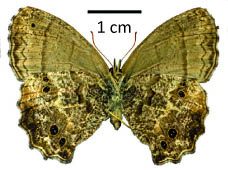Carminda
Andrew V. Z. Brower and Carlos Peña- Carminda umuarama
- Carminda paeon
- Carminda griseldis
Characteristics
Dias (2011) lists the following diagnostic features distinguishing species of Carminda from those of Moneuptychia:
Hindwing outer margins distinctly wavy.
Ventral hindwing median lines extended and distinctly angular.
Ventral fore- and hindwing color patterns contrasting.
Male genitalia: uncus laterally extended, latero-posterior apophyses of tegumen long, curvy and tapered at ends, angular appendices of tegumen not developed
Discussion of Phylogenetic Relationships
Carminda was considered a synonym of Moneuptychia by Lamas (2004), but, as pointed out by Freitas (2007), the phylogenetic analysis of Peña et al. (2006) shows Lamas' circumscription to be polyphyletic. This means at least that these species are not part of Moneuptychia, although whether Carminda is a distinct group from Pareuptychia remains to be seen.
References
Dias, MM. 1998. Designação da espécie tipo do gênero Carminda Ebert & Dias (Lepidoptera, Nymphalidae, Satyrinae). Revista Brasileira de Zoologia 15:1119.
Dias, MM. 2011. Taxonomic considerations on the genera Moneuptychia Forster and Carminda Dias, reval. (Lepidoptera, Nymphalidae, Satyrinae). Braz. J. Biol. 71, 537-540.
Ebert, H.,Dias, MM. 1997. Novos gênero e espécie de Satyrinae (Lepidoptera, Nymphalidae) do sudeste Brasileiro. Revta. bras. Zool. 14, 283-298.
Freitas, AVL. 2007 A new species of Moneuptychia Forster (Lepidoptera: Satyrinae, Euptychiina) from the highlands of southeastern Brazil. Neotropical Entomology 36, 919-925.
Lamas, G. (ed.) 2004 Atlas of Neotropical Lepidoptera. Checklist: Part 4A Hesperioidea - Papiionoidea. Gainesville: Scientific Publishers/Association of Tropical Lepidoptera.
Peña, C., Wahlberg, N., Weingartner, E., Kodandaramaiah, U., Nylin, S., Freitas, AVL. & Brower, AVZ. 2006 Higher level phylogeny of Satyrinae butterflies (Lepidoptera: Nymphalidae) based on DNA sequence data. Mol. Phylogenet. Evol. 40, 29-49.
Title Illustrations

| Scientific Name | Carminda paeon |
|---|---|
| Reference | Marín, M.A., Peña, C., Freitas, A.V.L., Wahlberg, N. & Uribe, S.I. (2011) From the phylogeny of the Satyrinae butterflies to the systematics of Euptychiina (Lepidoptera: Nymphalidae): history, progress and prospects. Neotropical Entomology 40, 1-13. (Fig.3.10) |
| Specimen Condition | Dead Specimen |
| Identified By | M. A. Marín |
| Sex | Female |
| Life Cycle Stage | adult |
| View | ventral |
| Copyright | © 2011 |
About This Page

Middle Tennessee State University, Murfreesboro, Tennessee, USA
Carlos Peña

University of Turku
Correspondence regarding this page should be directed to Andrew V. Z. Brower at and Carlos Peña at
Page copyright © 2012 and Carlos Peña
 Page: Tree of Life
Carminda .
Authored by
Andrew V. Z. Brower and Carlos Peña.
The TEXT of this page is licensed under the
Creative Commons Attribution License - Version 3.0. Note that images and other media
featured on this page are each governed by their own license, and they may or may not be available
for reuse. Click on an image or a media link to access the media data window, which provides the
relevant licensing information. For the general terms and conditions of ToL material reuse and
redistribution, please see the Tree of Life Copyright
Policies.
Page: Tree of Life
Carminda .
Authored by
Andrew V. Z. Brower and Carlos Peña.
The TEXT of this page is licensed under the
Creative Commons Attribution License - Version 3.0. Note that images and other media
featured on this page are each governed by their own license, and they may or may not be available
for reuse. Click on an image or a media link to access the media data window, which provides the
relevant licensing information. For the general terms and conditions of ToL material reuse and
redistribution, please see the Tree of Life Copyright
Policies.
- First online 06 January 2008
- Content changed 04 July 2012
Citing this page:
Brower, Andrew V. Z. and Carlos Peña. 2012. Carminda . Version 04 July 2012 (under construction). http://tolweb.org/Carminda/113127/2012.07.04 in The Tree of Life Web Project, http://tolweb.org/








 Go to quick links
Go to quick search
Go to navigation for this section of the ToL site
Go to detailed links for the ToL site
Go to quick links
Go to quick search
Go to navigation for this section of the ToL site
Go to detailed links for the ToL site